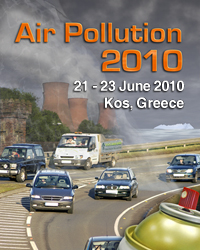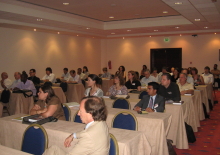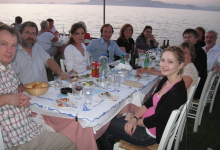18th International Conference on Modelling, Monitoring and Management of Air Pollution
21 - 23 June 2010
Kos, Greece
Overview
 The 18th International Conference on Modelling, Monitoring and Management of Air Pollution (Air Pollution 2010) has recently taken place on the island of Kos, Greece, organised by Professor Jim Longhurst from the University of the West of England and Professor Carlos A Brebbia from Wessex Institute of Technology (WIT).
The 18th International Conference on Modelling, Monitoring and Management of Air Pollution (Air Pollution 2010) has recently taken place on the island of Kos, Greece, organised by Professor Jim Longhurst from the University of the West of England and Professor Carlos A Brebbia from Wessex Institute of Technology (WIT).This successful international meeting built upon the prestigious outcomes of the 17 preceeding conferences beginning in Monterrey, Mexico in 1993 and most recently in Tallinn, Estonia, in 2009. These meetings have always attracted outstanding contributions from leading researchers from around the world. The presented papers have been permanently stored in the WIT eLibrary as Transactions of the Wessex Institute (see http://library.witpress.com). These papers provide an important online record of the development of science and policy pertaining to air pollution and they remain permanently available for researchers to access.
Despite the long history of attempts to manage the consequences of air pollution, it remains one of the most challenging problems facing the international community. Air Pollution is widespread and growing in importance: It has clear and known impacts on health and the environment. Human needs brings with it impacts in the atmospheric environment at scales from the local to the global. The continuing development of the global economy brings new pressures upon the ability of the atmosphere to process pollutants and to safely measure them. Where the natural processing systems of the atmosphere become overloaded and the systems are unable to process impacts to the atmosphere, at the rate they are added, then pollution results. This brings risks to human health and the environment. The willingness of governments to move quickly to regulate air pollution is often balanced by concerns over the economic impact of such regulation. This frequently results in a lag between the scientific knowledge about the structure, scale and effect of air pollution and the implementation of appropriate, targeted, timely legislation.
Opening Addresses
Professor Brebbia opened the meeting by referring to the importance of the conference programme to fulfil the function of WIT, i.e. to act as a mechanism for knowledge transfer, acting as a bridge between academia, research and industry,WIT research is carried out through a series of divisions, in addition to the Conference Division, which organises 25 or so international conferences per year. WIT also has two very active publishing and industrial support units.
WIT Press publishes nearly 50 books per year, only half of which are conference proceedings, the rest being state-of-the-art research books. It also produces three of the five Journals edited at the Institute and runs the Institute’s eLibrary. More and more of the publications, Professor Brebbia explained, are now sold and distributed in digital format which contributes to its rapid and wide dissemination.
The Industrial Unit at WIT carries out a series of advanced consulting and research contracts for industry. Of particular importance nowadays is the support provided to the offshore and aerospace industry. The Unit has been helping to design anti-corrosion systems for deepwater studies of the type that has experienced problems in the Gulf of Mexico. In those cases, it is essential that the corrosion protection systems are properly designed to ensure protection to all components and avoid negative effects due to the interaction of different systems.
Professor Brebbia ended by explaining the series of Medals and Awards that are run by the Institute, including the prestigious Prigogine Gold Medal which is given every year to the best scientist working on ecological systems. The medal was awarded in 2010 to Professor Felix Müller of the University of Kiel, in Germany, at a ceremony arranged at the Civic Centre of La Coruna in Galicia, North West Spain.

Professor Longhurst also referred to the friendliness of the Air Pollution conference series and the many contacts and joint initiatives that result from them.
Science remains the key to identifying the nature and scale of air pollution impacts, and is essential in the function of providing relevant information for regulatory decision-making. Science must also be able to provide the effects of impacts on air quality that results from the implementation of the mitigation measures or the environmental regulations. The ability to assess and mitigate using the precautionary principle is a challenge that science must grasp to convince decision-makers that uncertainty should not lead to inactivity. The virtues of such activities must be translated into a suitable format to assist policy makers in reaching sustainable decisions and to build public acceptance and understanding of the nature and scale of the air pollution challenge.
Contributions during the conference addressed a broad range of scientific and technical developments, increasing our understanding of the fundamental cause of air pollution and the effects of environmental pollutants.
Papers Air Pollution 2010 provide new data and presented reviews in the field of modelling, policy and management studies, global and regional studies, emissions, monitoring and measurement studies and impact studies.
Conference Topics
 The conference series consisted of papers on the following topics;
The conference series consisted of papers on the following topics;- Air Pollution Modelling
- Air Pollution Mitigation
- Aerosols and Particulates
- Monitoring and Measuring
- Indoor Air Pollution
- Exposure and Health Effects
- Emission Studies
- Innovative Indoor Air Quality Techniques
Invited Presentations
The programmes included a series of invited presentations by renown scientists.‘Air Quality Modelling as a tool for Sustainable Urban Traffic Management’ by M. Lopez and C. Borrego, University of Aveiro, Portugal

‘Application of laser induced fluorescence to monitor atmospheric polycyclic aromatic hydrocarbons’ by P.B.C. Forbes, University of Pretoria, South Africa
‘Mapping of ferrimagnetic susceptibility for screening of fly ash deposition’ by C Fürst, Dresden University of Technology, Germany
‘Indoor air quality assessment in a school building in Chennai City, India’ by S.M.S. Nagendra, Indian Institute of Technology, Madras
‘Remote sensing data assimilation in WRF-UCM mesoscale model: Madrid case study’ by R San-Jose, Politechnic University of Madrid, Spain
‘A Neural Network model for the estimation of bioclimatic indexes’ by F Patania, University of Catania, Italy
Special Session
The conference programme included a special session organised and chaired by Andrew Geens and his associates at the University of Glamorgan in South Wales. The session included the following presentations;- ‘The role of fabric diffusers in delivering indoor air quality and enhancing energy performance’
- ‘Ventilation to maintain indoor air quality in smoking rooms’
- ‘Modelling the multi-year maximum daily PM10 concentration in Edinburgh: An application of the variability decomposition transfer function model’
International Scientific Advisory Committee
 The meeting of the International Scientific Advisory Committee took place in a typical Greek Seafood Taverna on the seashore where the main course was a large and very fresh grupa fish, an authentic catch of the day accompanied by a series of specialties and seafood courses, and good Kos wines. The delegates discussed over dinner the improvements that could be made to the conference, including new topics, and the objectives of the meeting. The conference, now in its 18th year, has been able to survive because it continues to evolve reflecting emerging technologies and new topics of research.
The meeting of the International Scientific Advisory Committee took place in a typical Greek Seafood Taverna on the seashore where the main course was a large and very fresh grupa fish, an authentic catch of the day accompanied by a series of specialties and seafood courses, and good Kos wines. The delegates discussed over dinner the improvements that could be made to the conference, including new topics, and the objectives of the meeting. The conference, now in its 18th year, has been able to survive because it continues to evolve reflecting emerging technologies and new topics of research.Social Occassions and Excursions
The lunches offered by the Institute, together with the coffee breaks in common with other social occasions, gave the delegates ample opportunity for making contacts and holding informal discussions. Participants had also the occasion to attend a Greek night barbeque that took place in the hotel where a special table was reserved for the conference. Some of the most energetic attempted with varying degrees of success to join in the dancing. The occasion was most friendly and the delegates enjoyed the excellent cuisine and drinks offered by WIT.
Participants had also the occasion to attend a Greek night barbeque that took place in the hotel where a special table was reserved for the conference. Some of the most energetic attempted with varying degrees of success to join in the dancing. The occasion was most friendly and the delegates enjoyed the excellent cuisine and drinks offered by WIT.The conference dinner took place in a typical taverna on the seashore where participants had a fish meal with more Greek dancing at the end. The whole evening was most pleasant and delegates were able to relax in a friendly atmosphere.
 The special excursion that took place at the end of the conference was focused on a visit to the Asklepieion, an ancient hospital, where in 400BC Hippocrates set the foundations of modern medicine. Kos is also the place where the Hippocratic oath, still sworn today, was born. After an excellent guided tour of the Asklepieion, the delegates stopped at a local winery. There they tasted some of the excellent wines for which the island is becoming renown throughout the world.
The special excursion that took place at the end of the conference was focused on a visit to the Asklepieion, an ancient hospital, where in 400BC Hippocrates set the foundations of modern medicine. Kos is also the place where the Hippocratic oath, still sworn today, was born. After an excellent guided tour of the Asklepieion, the delegates stopped at a local winery. There they tasted some of the excellent wines for which the island is becoming renown throughout the world.The last part of the excursion consisted of taking a wooden craft to a private beach where they participated in a barbeque and had the occasion of swimming in the sea.
The day was most enjoyable and the delegates were happy to have had another opportunity to interact in a relaxing atmosphere.
Publication of Papers
The proceedings of Air Pollution XVIII, 464pp (Print ISBN: 978-1-84564-450-5; Online ISSN: 1743-3509) are available from WIT Press priced at £176/US$352/€246. Orders can be placed online at www.witpress.com or by email:Papers from the conference will also be hosted online in the WIT eLibrary as Volume 136 of WIT Transactions on Ecology and the Environment (ISSN: 1743-3509). For more details visit the WIT eLibrary at http://library.witpress.com


 Wessex Institute
Wessex Institute